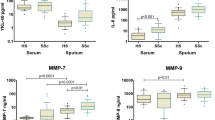Abstract
Background
To identify inflammatory cell types by phenotypic analysis of the inflammatory cells in the induced sputum.
Methods
This retrospective study included 1232 children and infants, who were assigned into mild/moderate groups (326) and severe group (602) by clinical symptom scores. Phenotypes of sputum inflammatory cells were analyzed using liquid-based thin-cytologic test and eosinophil-derived neurotoxin (EDN) was quantified by ELISA.
Results
Blood eosinophil count, serum total IgE level, and allergen detection rate were significantly higher in the severe group. In the 905 cases of qualified sputum, 526 cases exhibited at least one type of inflammatory cells, including neutrophil (343, 65.2%), eosinophil (161, 30.6%), and mixed granulocytes (22, 4.2%). Levels of neutrophils and eosinophils were significantly higher in the severe group than mild/moderate group, and eosinophil was predominant in the severe group. Serum EDN was 104.8 ± 39.4 μg/l in the eosinophil phenotype group, 112.6 ± 41.2 μg/l in the mixed group, 88.2 ± 36.6 μg/l in the neutrophil phenotype group, and 60.9 ± 34.6 μg/l in the paucigranulocytic phenotype group.
Conclusion
Induced-sputum inflammatory cell count may be used to determine phenotype of wheezing. The criteria of classifying adult asthma could be applicable for children and infants.
Similar content being viewed by others
Log in or create a free account to read this content
Gain free access to this article, as well as selected content from this journal and more on nature.com
or
References
Ducharme, F. M., Tse, S. M. & Chauhan, B. Diagnosis, management, and prognosis of preschool wheeze. Lancet 383, 1593–1604 (2014).
Mallol, J. et al. International prevalence of recurrent wheezing during the first year of life: variability, treatment patterns and use of health resources. Thorax 65, 1004–1009 (2010).
Garcia-Marcos, L. et al. International study of wheezing in infants: risk factors in affluent and non-affluent countries during the first year of life. Pediatr. Allergy Immu 21, 878–888 (2010).
Postma, D. S. & Rabe, K. F. The asthma-COPD overlap syndrome. N. Engl. J. Med 373, 1241–1249 (2015).
Heymann, P. W. et al. Viral infections in relation to age, atopy, and season of admission among children hospitalized for wheezing. J. Allergy Clin. Immunol. 114, 239–247 (2004).
Jackson, D. J. et al. Wheezing rhinovirus illnesses in early life predict asthma development in high-risk children. Am. J. Respir. Crit. Care Med. 178, 667–672 (2008).
Nair, H. et al. Global burden of acute lower respiratory infections due to respiratory syncytial virus in young children: a systematic review and meta-analysis. Lancet 375, 1545–1555 (2010).
Castrorodríguez, J. A. et al. A clinical index to define risk of asthma in young children with recurrent wheezing. Am. J. Resp. Crit. Care 162, 1403–1406 (2000).
Fahy, J. V. Eosinophilic and neutrophilic inflammation in asthma: insights from clinical studies. Proc. Am. Thorac. Soc. 6, 256–259 (2009).
Wenzel, S. E. Asthma: defining of the persistent adult phenotypes. Lancet 368, 804–813 (2006).
Massingham, K., Fox, S. & Smaldone, A. Asthma therapy in pediatric patients: a systematic review of treatment with montelukast versus inhaled corticosteroids. J. Pediatr. Health Care 28, 51–62 (2014).
Schleich, F. N. et al. Distribution of sputum cellular phenotype in a large asthma cohort: predicting factors for eosinophilic vs neutrophilic inflammation. BMC Pulm. Med. 13, 11 (2013).
Simpson, J. L. et al. Inflammatory subtypes in asthma: assessment and identification using induced sputum. Respirology 11, 54–61 (2010).
Tzanakis, N., Tsoumakidou, M. & Kyriakoy, D. Comparison of induced sputum inflammatory profiles between childhood and adult-onset asthma. Respir. Med. 100, 1442–1450 (2006).
Kim, C. K. Eosinophil-derived neurotoxin: a novel biomarker for diagnosis and monitoring of asthma. Korean J. Pediatr. 56, 8–12 (2013).
Alsamri, M. T. et al. Variability of sputum inflammatory cells in asthmatic patients receiving corticosteroid therapy: a prospective study using multiple samples. J. Allergy Clin. Immu 125, 1161–3.e4 (2010).
Siddiqui, S. & Brightling, C. E. Airways disease: phenotyping heterogeneity using measures of airway inflammation. Allergy Asthma Cl. Immu 3, 60–69 (2007).
Green, R. H. et al. Asthma exacerbations and eosinophil counts. A randomised controlled trial. Lancet 360, 1715–1721 (2002).
Acknowledgments
This study is supported by the key discipline project of Tianjin health and family planning commission (13KG125).
Author contributions
Y.Z. contributed to the study design, Y.G. and J.Z. prepared the manuscript, J. Li and J. Liu performed the data analysis, C.M. searched references, X.J. and L.Z. collected the data. All the authors made the final approval.
Data availability
The datasets supporting the conclusions of this article are included within the article.
Author information
Authors and Affiliations
Corresponding author
Ethics declarations
Competing interests
The authors declare no competing interests.
Ethical approval
The study protocol was approved by the Ethic Committee of Tianjin Children’s Hospital and conducted in accordance with Helsinki’s Declaration. All the patients gave their written information consent.
Additional information
Publisher’s note: Springer Nature remains neutral with regard to jurisdictional claims in published maps and institutional affiliations.
Rights and permissions
About this article
Cite this article
Guo, Y., Zou, Y., Zhai, J. et al. Phenotypes of the inflammatory cells in the induced sputum from young children or infants with recurrent wheezing. Pediatr Res 85, 489–493 (2019). https://doi.org/10.1038/s41390-018-0268-5
Received:
Revised:
Accepted:
Published:
Issue date:
DOI: https://doi.org/10.1038/s41390-018-0268-5



